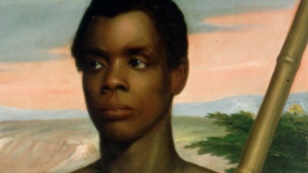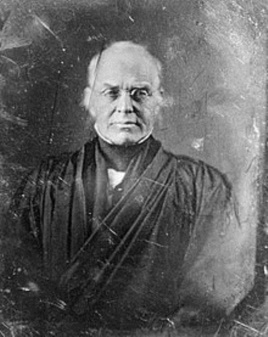VOA慢速英語:美國最高法院接管雅米斯泰德號奴隸船的案件
From VOA Learning English, welcome to The Making of a Nation — a weekly program of American history for people learning American English. I’m Steve Ember in Washington.
Last time, we talked about the Amistad case. The Amistad was a slave ship from Cuba. In 1839, it appeared off the eastern coast of the United States. The Africans on the ship had killed white crewmembers, including the captain. They demanded to go back home, to Africa. But the two remaining slave traders on the ship secretly sailed the Amistad toward the United States.
The US government put the Africans in a low-security prison in New Haven, Connecticut. And it made plans to take the Africans to court. A judge would decide whether the occupants of the ship were slaves who had rebelled, murderers, or captives who had been kidnapped from their homes.
 |
|
Joseph Cinque, or Sengbe Pieh, in a 1839 portrait by Nathaniel Jocelyn, overthrew the crew of the slave ship La Amistad. |
The Amistad case brought attention once again to the issue of slavery in the United States. At the time, slavery was legal and an important part of the country’s economy. But the U.S. — and several European countries — had banned the international slave trade.
A small group of activists wanted to totally end slavery. They believed slavery was a sin. But in the 1830s, most Americans did not support these anti-slavery activists, known as abolitionists.
“Most Americans first of all were racists and, secondly, saw these people asutter fanatics who were intent on destroying the union.”
Julie Roy Jeffrey is a professor of history at Goucher College in Maryland. She says newspapers reported on the Amistad case, and people began talking about slavery and the slave trade. Slowly, some Americans’ feelings toward the abolitionist movement and enslaved Africans changed.
“For example, there was a play put on in New York City called the Black Schooner that was based on the Amistad incident, and there were many, many people who went to see it. It became a popular event. And wax figures of the captives were exhibited in various places in the United States, and artists drew pictures of them.”
The abolitionists wanted to make more Americans sympathetic to the Amistad Africans. They found lawyers to represent them, paid tutors to teach them, and organized outdoor exercises to keep them healthy and visible.
Howard Jones taught history at the University of Virginia. He says one of the most popular members of the Amistad Africans was an eight-year-old boy who had learned English. The boy told the public about his life in Africa and about the conditions on the slave ship that brought him across the Atlantic Ocean.
The Amistad case also was increasingly becoming a political issue. People wanted to know what President Martin Van Buren was going to do about the case.
Historian Howard Jones says Van Buren found the position difficult. He did not want to anger southern voters, who supported slavery and wanted to make the African slave trade legal again. He also did not want to anger northern voters who believed the Amistad Africans had been mistreated.
“Van Buren did what any good politician would do. And that was to try to dodge the issue. Stay away from it. He couldn’t understand why 40 plus by this time black people should affect anything happening in high political society.”
But the Amistad issue would not go away. The case began in a circuit court. After three days it went to a district court. The district court judge ruled that the African slave trade was illegal under international treaties; for that reason, the Africans were wrongly taken.
Amistad Issue Reaches Nation’s Highest Court
President Van Buren was worried the decision would cause more political problems for him. So he ordered the nation’s highest court, the Supreme Court, to hear the case.
The chief justice of the Supreme Court at that time was Joseph Story. Story did not like slavery, but he did not support the abolitionist movement either. He thought its ideas opposed the rule of law.
 |
|
An 1844 Daguerrotype of Supreme Court Chief Justice Joseph Story. |
The abolitionists had good lawyers, but they knew they needed more help arguing their case in the Supreme Court. So they turned to former president John Quincy Adams.
At the time, Adams was a congressman, not an abolitionist. But he led a campaign against an 1836 rule restricting anti-slavery petitions. Adams said the rule was a violation of the constitutional right to petition Congress. Historian Julie Jeffrey says the 1836 “gagrule,” as it was called, helped the abolitionists’ cause.
“It became partly a freedom of speech issue, not just about slavery, but about the rights of citizens to speak out and to be heard by their representatives in Congress.”
Yet John Quincy Adams was not excited about arguing the Amistad case. He was 72-years-old, nearly blind, and very busy. But the issue of the Amistad Africans troubled him. Howard Jones says Adams believed capturing people and enslaving them was immoral – especially in a country like the United States. In the end, Adams agreed to defend the Africans.
“And he makes the argument in the court case that we have the Declaration of Independence right there on that wall and that says that life, liberty, the pursuit of happiness… It doesn’t say for white people only, or anything like that. He was arguing, trying to argue, that it’s something that’s available for everyone, it’s part of the justice system.”
Chief Justice Joseph Story did not totally accept Adams’ argument, or suggest that any kind of slavery was wrong. But he did agree with the district court that these Africans had been taken illegally from their homes. They were not and had never been slaves, Justice Story said. They were free people and should be returned home.
Amistad Captives Allowed to Return to Africa
So, in 1841, the remaining thirty or so members of the Amistad captives got on a ship called The Gentleman and returned to West Africa. Howard Jones says the incident was the only time he knows that black people who had been brought to the new world as slaves actually made it back home.
“And how they do it? By winning in the American court system. This was just unheard of. But the decision was basically that it doesn’t matter whether you are black, white, purple, green or whatever color you are, you have been kidnapped. And so therefore you have — and Joseph Story said this in his decision, which really opened the door for a lot of arguments — that under the eternal principles of justice, you have the inherent right of self-defense, even if you must kill your captors.”
Howard Jones says the Supreme Court decision also gave the abolitionists anew sense of power.
“And the abolitionists immediately printed pamphlets, leaflets, had talks, everything they could to show that these people went free, and their implication was, this is what’s going to happen to slavery itself. That this is a great victory for the black man.”
But the Amistad case did not really change the situation in the United States for most black people. Many were the children of slaves and could not argue they had been kidnapped from Africa. And, it was still legal to trade slaves across US state borders.
The Amistad case also did not solve all the problems in the abolitionist movement. Julie Roy Jeffrey says during the trials, many abolitionists worked together, including blacks and whites.
“It sometimes worked very well, and it sometimes didn’t work so well, but it was certainly one of the first times that blacks and whites had worked so fruitfully together.”
After the Amistad victory, though, the abolitionist movement broke into different groups. Ms. Jeffrey says some black abolitionists wanted more respect from white activists.
Other abolitionists just had different ideas about how best to end slavery: by trying to change the country’s laws, or by appealing to Americans’ moral sense of right and wrong.
Abolitionism did influence other movements, however. One was the missionary movement. Julie Roy Jeffrey says Christian missionaries had already been going to Africa, hoping to persuade people to follow their religion. But the Amistad case and abolitionism made more people want to share their beliefs with others.
Some missionaries even converted the Amistad captives to Christianity and returned to West Africa with them.
Abolitionist Movement Helps Women’s Rights
Ms. Jeffrey says the abolitionist movement also helped create the women’s movement in the middle of the 1800s. She says most 19th century white women mainly cared for their families in the home, but women abolitionists played an important public role.
“They weighed in on the most political question of the day. They took on activities like collecting petition signatures and raising money and giving speeches.”
As a result, Ms. Jeffrey says, some women came to believe they had a right to develop their own beliefs and have political power.
“Sometimes they propped up their activism by appealing to things like the Bible. One woman I remember said something like, ‘I read my Bible, and I know what it tells me.’ And she was opposing the minister in her church and she was a very active abolitionist.”
Yet even if abolitionism still did not personally affect most Americans, it made an increasing number of people question whether they wanted slavery to continue.
Next week on our program, we will tell about the short presidency of William Henry Harrison. And we will continue talking about how slavery influenced presidents and politics over the coming years.
I’m Steve Ember, inviting you to join us next time for The Making of a Nation —American history from VOA Learning English.
- 用戶搜索
瘋狂英語 英語語法 新概念英語 走遍美國 四級聽力 英語音標(biāo) 英語入門 發(fā)音 美語 四級 新東方 七年級 賴世雄 zero是什么意思濰坊市青云湖小區(qū)英語學(xué)習(xí)交流群
- 頻道推薦
- |
- 全站推薦
- 推薦下載
- 網(wǎng)站推薦




















